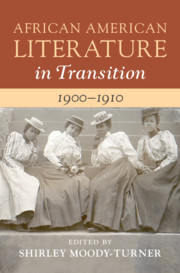Book contents
- African American Literature in Transition, 1900–1910
- African American Literature in Transition
- African American Literature in Transition, 1900–1910
- Copyright page
- Contents
- Figures
- Contributors
- Preface
- Acknowledgments
- Chronology, 1900–1910
- Introduction
- Part I Transitions in African American Authorship, Publishing, and the Visual Arts
- Part II New Negro Aesthetics and Transitions in Genre and Form
- Chapter 4 African American Novels and the New Slavery in the New South
- Chapter 5 Anti-Lynching Poetry and the Poetics of Protest
- Chapter 6 The Politics of Performance, Character, and Literary Genre in Transition
- Part III Modernist Masculinities and Transitions in Black Leadership
- Part IV Remapping the Turn of the Twentieth Century
- Index
Chapter 6 - The Politics of Performance, Character, and Literary Genre in Transition
from Part II - New Negro Aesthetics and Transitions in Genre and Form
Published online by Cambridge University Press: 29 April 2021
- African American Literature in Transition, 1900–1910
- African American Literature in Transition
- African American Literature in Transition, 1900–1910
- Copyright page
- Contents
- Figures
- Contributors
- Preface
- Acknowledgments
- Chronology, 1900–1910
- Introduction
- Part I Transitions in African American Authorship, Publishing, and the Visual Arts
- Part II New Negro Aesthetics and Transitions in Genre and Form
- Chapter 4 African American Novels and the New Slavery in the New South
- Chapter 5 Anti-Lynching Poetry and the Poetics of Protest
- Chapter 6 The Politics of Performance, Character, and Literary Genre in Transition
- Part III Modernist Masculinities and Transitions in Black Leadership
- Part IV Remapping the Turn of the Twentieth Century
- Index
Summary
When Pauline Elizabeth Hopkins wrote and published her serial novel Hagar’s Daughter: A Story of Caste Prejudice in the Colored American Magazine from 1901 to 1902, African Americans’ struggle for sociopolitical recognition seemed reflected in two images: Booker T. Washington’s White House dinner and lynching postcards. The political implications of the Washington visit and the lynching epidemic appear to be squarely at odds with one another, yet Hopkins, a former singer and actress, editor, and novelist, proposes in Hagar’s Daughter that an important connection binds them: a politics of performance. Like many writers of her time, Hopkins moved away from realism. However, she did not do so to undertake determinism as an explanation for African American evolution or devolution. Instead, Hopkins turned toward the concept of performance to interrogate American epistemologies of sociopolitical progress.
Keywords
- Type
- Chapter
- Information
- African American Literature in Transition, 1900–1910 , pp. 146 - 172Publisher: Cambridge University PressPrint publication year: 2021

